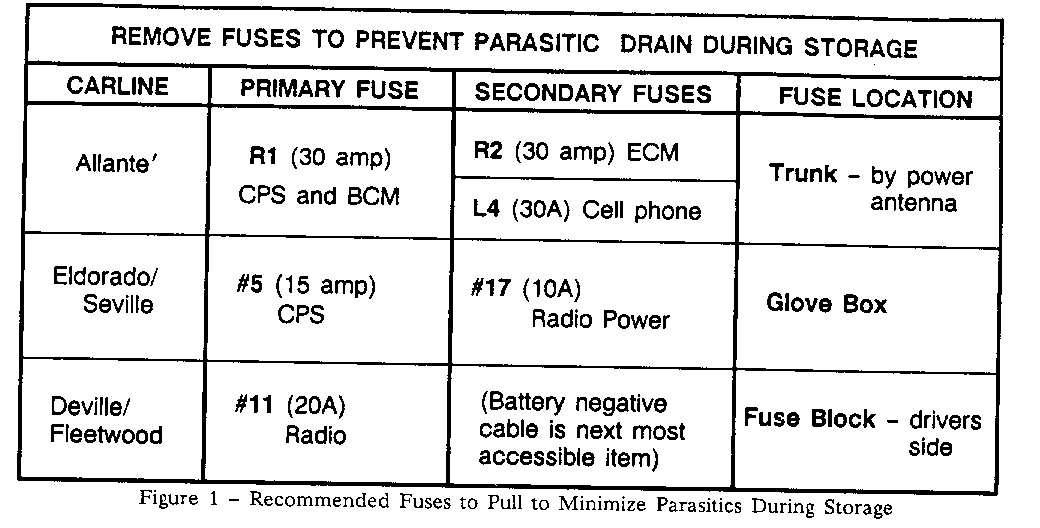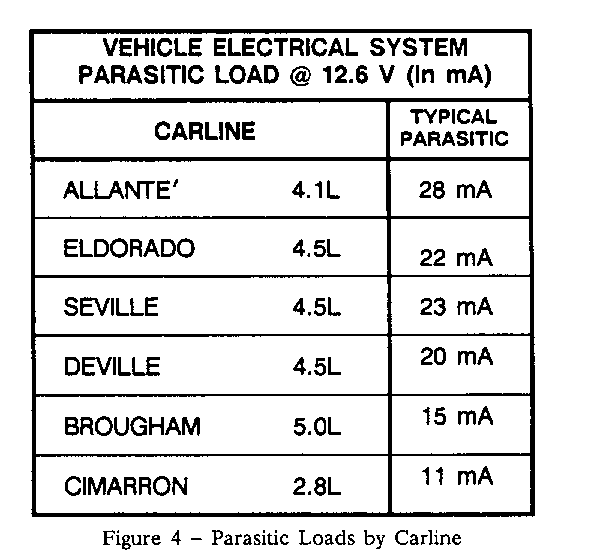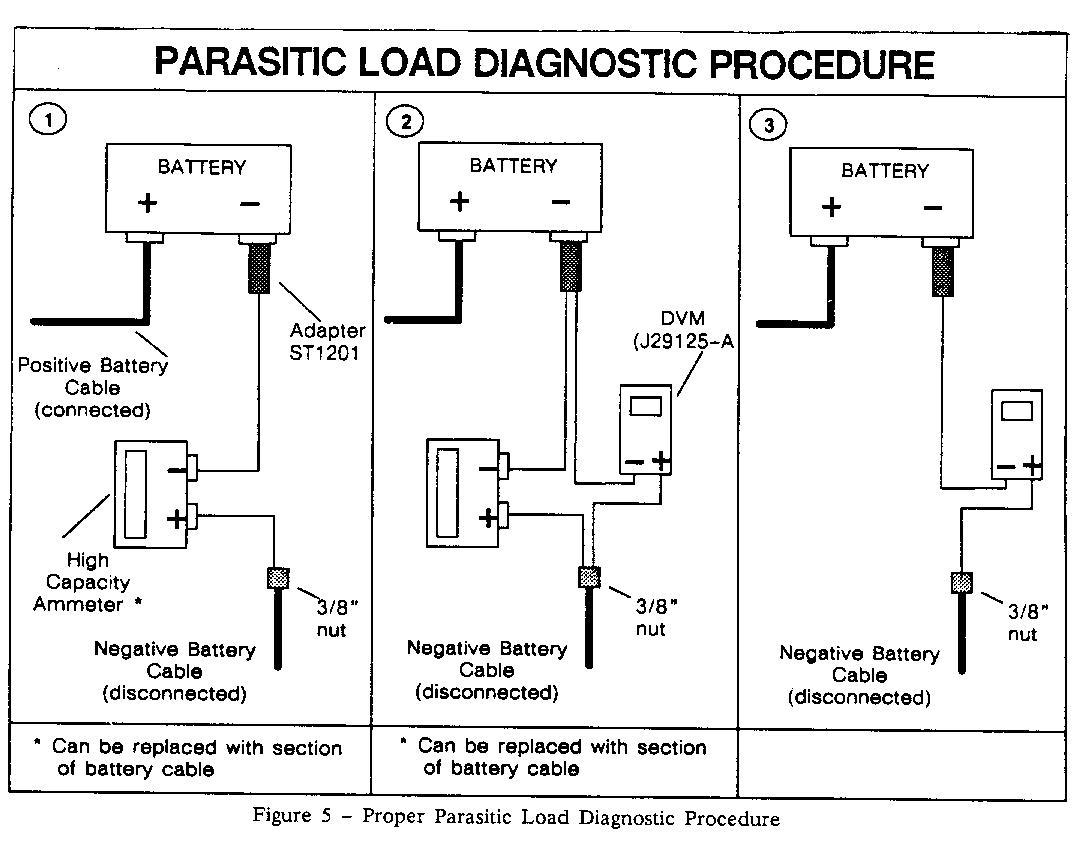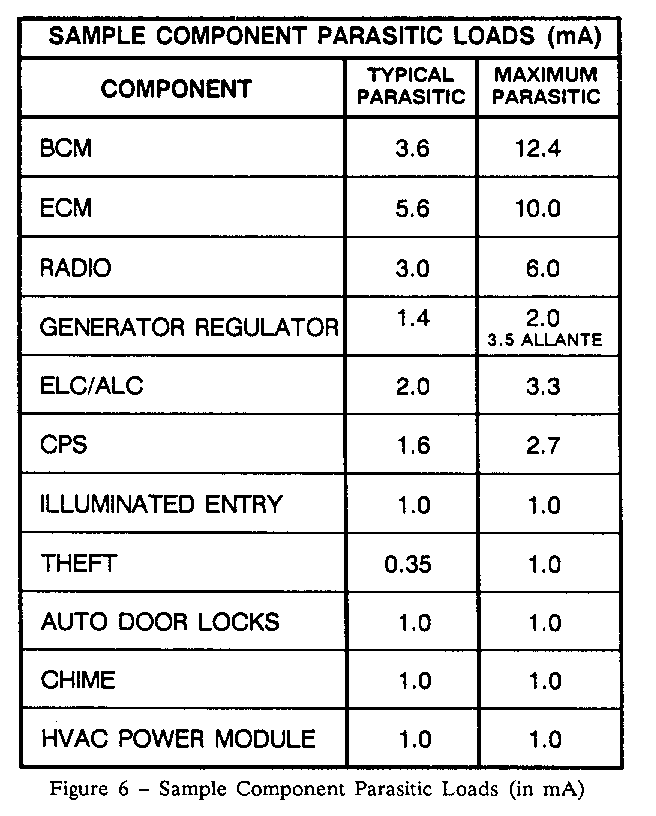DELCO BATTERY STORAGE TESTING DIAGNOSIS AND CHARGING

DELCO FREEDOM BATTERY DIAGNOSIS AND CHARGING PROCEDURE
VEHICLES AFFECTED: ALL 1988-89 CADILLACS ------------------
This bulletin outlines the following service information:
I. Battery Storage: (In-Vehicle storage) Discusses battery storage procedures, parasitic loads, and includes a chart of fuses to pull to reduce these loads during storage.
II. Testing: Some brief tips for visual inspection and charging cautions.
III. Diagnosing Parasitics: Contains an important procedure required to properly test 1986-1988 E/K and 1987-1988 V vehicles for parasitic drains (recommended for all carlines).
IV. Charging: Tips relating to quick charging procedures. Also lists other sources of information.
Read all this information. Try recharging a deeply discharged battery; review training materials if necessary. The majority of deeply discharged batteries can be recharged if proper procedures are followed.
CAUTION:
Batteries produce explosive gases. Always shield eyes and face from battery. Cigarettes, flames, or sparks could cause battery to explode. Do not charge or use booster cables or adjust terminal post connections without proper instructions and training.
Batteries also contain sulfuric acid which can cause severe burns. Avoid contact with skin, eyes or clothing. In the event of accident, flush with water and call a physician immediately.
I. BATTERY STORAGE IN VEHICLE ----------------------------- Vehicles have several electronic devices which result in very small but continuous current drains on batteries, commonly referred to as "parasitic loads". Parasitic loads may cause vehicles not used for an extended period of time to develop deeply discharged and/or permanently damaged batteries. Discharged batteries can freeze at temperatures as high as -6 Deg. C (+20 Deg. F), causing permanent damage. Batteries that have been frozen should be scrapped. Never attempt to recharge or use a battery which has been frozen.
To prevent frozen or damaged batteries, assure that the battery green dot is visible before storing the vehicle. The negative battery cable should be disconnected on vehicles which are not going to be in service within a 30-day period. If this is not possible, batteries should be recharged periodically, every 30-60 days, until the green dot is visible (see section on charging).
NOTE: Disconnecting the battery may disable any vehicle security/ anti-theft systems!
NOTICE: The ignition switch, headlights, RAP, etc., must be off when connecting or disconnecting battery jumper cables or chargers. Failure to do so may over-stress or damage the ECM or other electronic components. Disconnecting jumper cables with the engine running may cause voltage surges that could damage headlamp bulbs or other electronic components.
When disconnecting the negative battery cable is not practical for storage, Figure 1 can be used to determine which fuses should be pulled to minimize the parasitic drain. The "Primary" fuse should be pulled and placed in a location in the vehicle where sales and service personnel can easily find and reinstall it. The fuse-pull suggestions found below are not designed to completely eliminate parasitic load; only disconnecting the battery negative cable can accomplish this. Rather, it should help eliminate some of the major draws in a convenient manner.
II. TESTING THE BATTERY -----------------------
A. Visual Test ----------- Check for obvious damage, such as cracked or broken case or cover that is permitting loss of electrolyte. If obvious damage is noted, replace the battery. Determine the cause of damage and correct as needed. If battery terminals are severely damaged, for instance loose, burned, or broken, replacement of the battery is recommended.
Evidence of small amounts of electrolyte leakage, especially around the vent holes, does not necessarily indicate the battery s defective. The leakage could have been caused by overcharging or tipping of the battery. If a small amount of the electrolyte leakage is detected, the battery should be fully charged OUT OF THE VEHICLE so that any electrolyte that may escape does not damage the bumper filler panels or other components
B. Reading Built-In Hydrometer --------------------------- Look straight down into the built-in hydrometer to observe its reading, clean and use a flashlight if necessary, and tap lightly on top of the hydrometer to dislodge any trapped air bubbles that might prevent a correct reading. Refer to Figure 2.
III. DIAGNOSING DISCHARGED BATTERIES AND PARASITIC BATTERY DRAINS ----------------------------------------------------------------- All no-start, slow cranking, and/or frequently discharged battery conditions should be thoroughly diagnosed to avoid unnecessary replacement of batteries. The battery should be charged and load tested in accordance with established service procedures as described in the Service Information Manual before considering battery replacement. Examples of conditions causing low charged or discharged batteries are:
o Extended storage of vehicles o Batteries already discharged when vehicle is received, due to handling in transit and at assembly o Extended cranking periods due to plug fouling o Accessory lights left on with engine not running (courtesy, glove box, trunk lights) o Insufficient recharge (ampere-hours) of discharged battery o Charging system problems o Continuous current draw on battery through parasitic drain
As was discussed above in "Battery Storage", todays vehicles have several electronic devices which result in very small but continuous current drains on their batteries, commonly referred to as "parasitic loads". A parasitic drain of up to 5OmA is considered normal, 3OmA being about average. Any battery draw above 5OmA, with ignition off and retained accessory power disabled (if so equipped), is excessive. Figure 3 below gives approximate average values of design parasitic current draw for each carline.
Also, refer to the table of component parasitic loads found above under "Battery Storage". These values should only be used as general guidelines when diagnosing suspect components.
A. How to Check the Battery Drain (Refer to Figure 4) -------------------------------------------------- When checking any type of current draw, it is important to use an ammeter or digital multi-meter to measure the amperage.
The electrical circuitry of most vehicles require that the Body Computer Module (BCM) and the Central Power Supply (CPS) get an initialization charge whenever the battery power is first provided. This initialization occurs with the ignition key in the "OFF" position, and depending on how long the battery has been disconnected, the initial draw may last from 1 to 3 seconds and can range between 0.5 and 9.0 amps. Therefore, to prevent misleading readings or unnecessary fuse replacement on the digital multi- meter, J-29125, or similar equipment, the following procedure is recommended. THIS PROCEDURE IS PARTICULARLY CRITICAL ON THE 1987-1988 ALLANTE AND THE 1986-1988 ELDORADO AND SEVILLE. It is recommended as a good practice for all vehicles.
1. Disconnect the negative battery cable.
2. Install a battery side terminal adapter, AC-Delco ST1201 or equivalent, in the negative terminal of the battery.
3. Install a 3/8 nut, with standard threads (16 UNC) on the negative battery cable attaching screw to assure a good electrical contact with the lead face on the cable for testing. Yellow or black finish nuts are generally nonconductive and should not be used.
4. With all lights, accessories, Retained Accessory Power (RAP), and the ignition switch off, connect a high capacity ammeter at least 10 amps from the negative battery cable to the side terminal adapter. This high capacity ammeter is connected to verify whether or not a high current draw is occurring at a constant rate. It is this type of high current draw which will blow the fuse in lower capacity ammeters. After the initial draw occurs, the ammeter reading should drop below 1 amp.
NOTE: If a high capacity ammeter is not available, install a section of heavy wire (preferably a battery cable) between the existing battery negative cable and the side terminal adapter. Allow ample time (approximately 30-60 seconds) for the initial draw to occur and proceed to step 5.
5. With the high capacity ammeter or battery cable section still connected, connect the digital multi-meter, set to the 2000 DCmA range, in parallel with the high reading ammeter,
6. Disconnect the high capacity ammeter and take the reading with the digital multi-meter.
A current draw of 5OmA or less (see values in Figures 3 and 5) indicates that all lights and accessories are off and that there is no unexplained current draw. Care should be taken to allow for a time delay before reading the meter on vehicles equipped with Electronic Level Control (ELC).
Due to this initialization process, test lamps CANNOT be used in place of ammeters to diagnose current draw conditions. The voltage drop across the test lamp prevents the initialization process from occurring.
Clamp-On Ammeters:
Clamp-on ammeters may be used if the meter can measure in the milli-amp range and if the meter clamp can fit around all of the battery negative or positive cables. All of the cables must fit in the clamp with the clamp closed to be sure that all of the parasitics are being measured. Zero the clamp-on ammeter carefully. Magnetic fields from engine electrical items (generator, ignition, solenoids) and from shop sources (fluorescent lights, power cables) can alter the clamp-on meter readings. If the parasitic readings are not repeatable, use the series measurement method described in this bulletin.
B. Determining the Source of the Drain ----------------------------------- Once it has been determined that a parasitic drain in excess of 50 mA exists, a visual inspection of the vehicle should be conducted. Check to see if there are any unwanted lights on, motors running or switches/relays activating.
If no cause for the draw is immediately apparent, it may be possible to narrow in on the source by systematically removing fuses and circuit breakers, one by one, from the fuse panels. This should be done while monitoring the ammeter so that a disruption of the drain will be evident. Refer to Figure 3 for average and maximum parasitic loads for various vehicle components.
Figure 5 below gives an approximate indication of typical and maximum parasitic loads by component in milli-amps (mA).
In addition to parasitic loads, a certain amount of selfdischarge is always occurring as a result of internal chemical reactions even when the battery is not connected. The higher the ambient temperature, the greater the amount of self-discharge.
This explains why the number of discharged batteries may increase at your location in very hot weather. The original equipment battery has a much lower rate of self-discharge than conventional batteries, however, self-discharge at 38 Deg. C (100 Deg. F) ambient can be as high as 7mA.
IV. BATTERY CHARGING --------------------
NOTES:
1. The majority of discharged batteries can be recharged using normal battery charging procedures. Some deeply discharged batteries or batteries which have been allowed to remain in a discharged state may need a higher charge voltage initially to start the recharging process.
2. The Freedom battery is more resistant to overcharging damage than conventional batteries. Boost or Quick-Charge settings on battery chargers may be safely used in most instances. (This is not true of other non-Delco OE batteries and many aftermarket batteries.)
3. With the battery at room temperature, voltages as high as 15.0 volts to 16.0 volts may be safely used without causing battery damage. - Cold batteries require more voltage to cause them to accept current. Warm batteries will accept less voltage without causing overcharging.
4. After starting the battery on charge and periodically during the charging process, the battery should be checked to assure that it is not overcharging. Overcharging can be identified by excessive battery case temperature and electrolyte boiling or bubbling (or spewing out the vents).
o Battery case temperatures of about 50 Deg. C (125 Deg. F) is the maximum which should be allowed. Check by hand feel and reduce the charge rate if high temperatures are found.
o Excessive electrolyte bubbling or boiling indicates that the charge voltage is too high and that the battery is being forced to accept too much current. Turn down the charge rate if high temperatures are found.
o A battery with an internally shorted cell will show signs of overcharging at normally acceptable voltages. If charge voltages of around 13 volts result in overcharging (on a battery at room temperature or cooler), disconnect the battery and check the voltage. Batteries with internal shorts will exhibit a drop in voltage over time. Batteries with internal shorts should be scrapped.





General Motors bulletins are intended for use by professional technicians, not a "do-it-yourselfer". They are written to inform those technicians of conditions that may occur on some vehicles, or to provide information that could assist in the proper service of a vehicle. Properly trained technicians have the equipment, tools, safety instructions and know-how to do a job properly and safely. If a condition is described, do not assume that the bulletin applies to your vehicle, or that your vehicle will have that condition. See a General Motors dealer servicing your brand of General Motors vehicle for information on whether your vehicle may benefit from the information.
